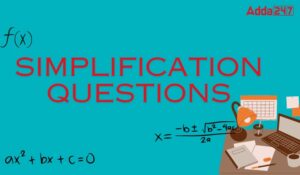Dear Students,
Quantitative Aptitude Questions for IBPS Exam
You should try to attempt this quantitative aptitude questions test within 16-17 minutes. If you fail to complete it in the stipulated time, then try again with full force. Quant is a scoring section and these questions are very important for IBPS RRB Exam, IBPS PO, IBPS Clerk, other banking, and insurance sector recruitment exams.
Directions (1-6): What should come in place of question mark(?) in the questions given below?(you are not expected to get exact values).
Q7. A vessel contains 100 litres mixture of milk and water in the respective ratio of 22: 3. 40 litres of the mixture is taken out from the vessel and 4.8 litres of pure milk and pure water each is added to the mixture. By what percent quantity of water is less than the quantity of milk?
Q8. In a vessel, there is a mixture of apple, orange and mango juices in the ratio of 3: 5: 4 respectively. A quantity of 12 litres from the mixture is replaced by 8 litres of apple juice. Thereafter the quantities of apple and orange juices in the resultant mixture become same. Find out the initial quantity of mixture in the vessel.
(a) 76 litres
(b) 65 litres
(c) 60 litres
(d) 80 litres
(e) None of these
Q9. A 20 litres mixture contains milk and water in the respective ratio of 3: 2. Then 10 litres of the mixture is removed and replaced with pure milk and the operation is repeated once more. At the end of the two removals and replacements, what is the ratio of milk and water in the resultant mixture respectively?
(a) 17 : 3
(b) 9: 1
(c) 4: 17
(d) 5 : 3
(e) 3: 14
Q10. A jar has 60 litres of milk. From the jar, 12 litres of milk was taken out and replaced by an equal amount of water. If 12 litres of the newly formed mixture is taken out of the jar, what is the final quantity of milk left in the jar?
(a) 38.4 litres
(b) 40 litres
(c) 36 litres
(d) 28.6 litres
(e) 36.5 litres
Directions (11-15): Study the following graph carefully to answer the questions that follow:
Q11. The number of girls from Biology department is approximately what percent of the total number of girls from all the departments together?
(a) 32
(b) 21
(c) 37
(d) 43
(e) 27
Q12. What is the difference between the total number of boys and the total number of girls from the departments together?
(a) 440
(b) 520
(c) 580
(d) 460
(e) None of these
Q13. What is the average number of boys from all the departments together?
(a) 122
(b) 126
(c) 130
(d) 134
(e) None of these
Q14. The number of boys from Anthropology department is approximately what percent of the total number of boys from all the departments together?
(a) 15
(b) 23
(c) 31
(d) 44
(e) 56
Q15. What is the respective ratio of the number of girls from Philosophy department to the number of girls from Psychology department?
(a) 1: 2
(b) 7: 12
(c) 5: 12
(d) 3: 4
(e) None of these
You may also like to Read:





 Simplification Questions For Bank Exams ...
Simplification Questions For Bank Exams ...
 Quantity Comparison Questions for Bank E...
Quantity Comparison Questions for Bank E...
 Mixture & Alligation Questions for B...
Mixture & Alligation Questions for B...




